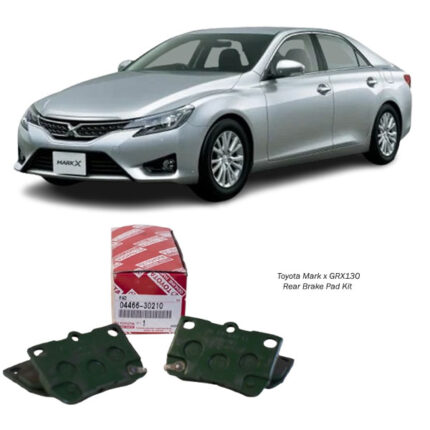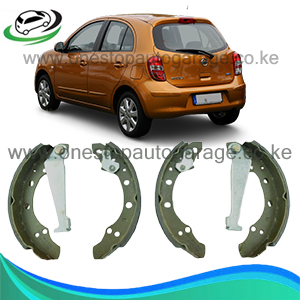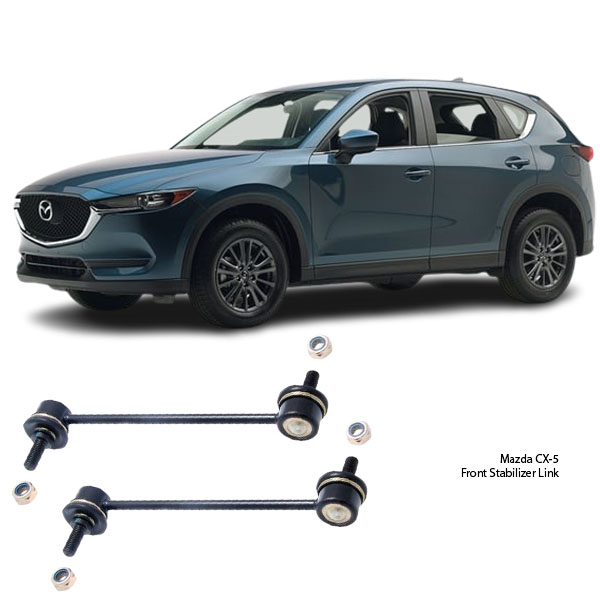-17%
Get Mazda CX5 Front Stabilizer Link Assy 0523-KEF in Kenya
The front stabilizer link assembly, also known as the anti-roll bar link or sway bar link, is a critical component of a vehicle’s suspension system. It connects the stabilizer bar (sway bar) to the suspension control arms or struts, helping to reduce body roll and improve vehicle stability when cornering.
Without a properly functioning stabilizer link, a vehicle may experience excessive body roll, poor handling, and increased tire wear. This component plays a key role in balancing the suspension and ensuring a smooth and safe ride.
This guide will cover:
- Functions of the front stabilizer link assembly
- Benefits of a properly functioning stabilizer link
- Signs of a worn-out stabilizer link
- Replacement and maintenance tips
2. Functions of the Front Stabilizer Link Assembly
2.1 Reduces Body Roll
- The stabilizer link connects the stabilizer bar to the suspension, preventing excessive side-to-side movement of the vehicle during turns.
- It distributes forces between the left and right wheels, keeping the vehicle level.
2.2 Improves Vehicle Stability
- Enhances cornering performance by reducing excessive tilting or leaning.
- Keeps all four wheels in better contact with the road, improving grip and control.
2.3 Enhances Ride Comfort
- Prevents harsh jolts and sudden weight shifts when driving over uneven surfaces.
- Works alongside shock absorbers and struts to smooth out the ride.
2.4 Supports Suspension Components
- Helps prevent uneven stress on other suspension parts, such as control arms and struts.
- Reduces premature wear on tires, ball joints, and bushings.
3. Benefits of a Well-Maintained Stabilizer Link Assembly
3.1 Better Handling and Control
- A new or well-functioning stabilizer link keeps the vehicle stable even during sharp turns.
- Reduces the risk of losing control in emergency maneuvers.
3.2 Extended Suspension Lifespan
- Prevents uneven forces from damaging ball joints, struts, and control arms.
- Reduces stress on the stabilizer bar and bushings.
3.3 Improved Driving Comfort
- Ensures a smoother ride by reducing excessive tilting and bouncing.
- Absorbs minor road shocks, keeping the ride stable.
3.4 Reduced Tire Wear
- Prevents uneven tire wear caused by excessive suspension movement.
- Ensures proper alignment of wheels for better traction and durability.
4. Common Signs of a Worn-Out Stabilizer Link
4.1 Clunking or Knocking Noises
- A damaged stabilizer link can cause clunking or knocking sounds when driving over bumps.
- This noise indicates loose or worn-out bushings and ball joints within the link.
4.2 Poor Handling and Stability
- Excessive body roll when cornering is a sign of a failing stabilizer link.
- If the vehicle feels unstable or wobbly, the stabilizer link may be broken or loose.
4.3 Uneven Tire Wear
- If the stabilizer link is worn out, excessive suspension movement can lead to uneven tire wear patterns.
- This results in reduced tire lifespan and poor road grip.
4.4 Steering Feels Loose or Unresponsive
- A failing stabilizer link affects steering precision, making the vehicle feel less responsive.
- Drivers may notice more effort is required to keep the vehicle straight on highways.
4.5 Visible Wear or Damage
- Inspecting the stabilizer link can reveal cracked rubber bushings, bent metal rods, or loosened bolts.
- A completely broken stabilizer link will have detached joints, making it non-functional.
5. Causes of Stabilizer Link Failure
5.1 Normal Wear and Tear
- Stabilizer links are subject to constant movement and wear out over time, especially after 50,000 – 100,000 km.
5.2 Driving on Rough Roads
- Potholes, bumps, and uneven roads put extra stress on stabilizer links, leading to faster wear.
5.3 Corrosion and Rust
- Exposure to moisture, dirt, and road salt can cause rust buildup, weakening the stabilizer link.
5.4 Overloading the Vehicle
- Excessive weight increases suspension strain, putting more stress on the stabilizer links.
5.5 Impact Damage from Accidents
- Hitting curbs, potholes, or being involved in an accident can bend or break stabilizer links.
6. Replacing the Front Stabilizer Link Assembly
6.1 Tools Required
- Jack and Jack Stands – To lift the vehicle.
- Socket Wrench Set – For removing and installing bolts.
- Penetrating Oil – Helps loosen rusted bolts.
- Torque Wrench – Ensures correct tightening.
6.2 Replacement Steps
Step 1: Lift the Vehicle
- Park the car on a level surface.
- Use a jack to lift the front of the car and secure it with jack stands.
Step 2: Locate and Remove the Old Stabilizer Link
- Identify the stabilizer link connected to the sway bar and control arm.
- Use a wrench and socket to remove the bolts holding the link in place.
Step 3: Install the New Stabilizer Link
- Align the new stabilizer link with the control arm and sway bar.
- Tighten the bolts using a torque wrench to manufacturer specifications.
Step 4: Lower the Vehicle and Test Drive
- Lower the vehicle and take it for a short drive.
- Listen for noises and check for any steering or suspension issues.
7. Maintenance Tips for Long-Lasting Stabilizer Links
7.1 Regular Inspections
- Check the stabilizer link during oil changes or suspension maintenance.
- Look for loose bolts, worn bushings, or rust.
7.2 Avoid Rough Roads
- Driving carefully over bumps and potholes helps prolong stabilizer link life.
7.3 Replace in Pairs
- If one stabilizer link fails, replace both sides for balanced suspension performance.
7.4 Use High-Quality Replacement Parts
- Opt for OEM or high-quality aftermarket stabilizer links to ensure durability.
7.5 Lubricate Suspension Components
- Apply silicone grease to bushings to prevent premature wear.
8. Frequently Asked Questions (FAQs)
8.1 Can I Drive with a Broken Stabilizer Link?
- It’s possible, but not recommended. A broken stabilizer link compromises stability and handling, increasing the risk of accidents.
8.2 How Long Does a Stabilizer Link Last?
- Typically 50,000 to 100,000 km, depending on road conditions and driving habits.
8.3 Is It Expensive to Replace a Stabilizer Link?
- Stabilizer links are affordable compared to other suspension components. Labor costs vary by location.
8.4 Can a Bad Stabilizer Link Cause a Noisy Suspension?
- Yes. Clunking, knocking, or rattling noises are common signs of a bad stabilizer link.
9. Conclusion
The front stabilizer link assembly plays a crucial role in vehicle stability, handling, and safety. It minimizes body roll, enhances cornering performance, and protects other suspension components from premature wear.
Regular inspections and timely replacement of worn stabilizer links ensure a comfortable and controlled driving experience. By following proper maintenance practices, drivers can prolong the life of their stabilizer links and maintain their vehicle’s suspension performance.
Follow us on Facebook for more parts.



